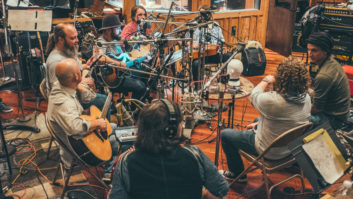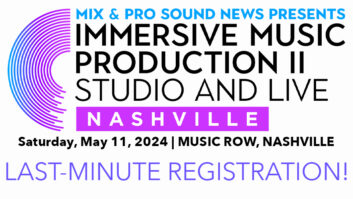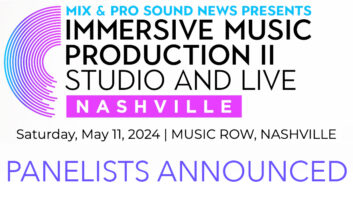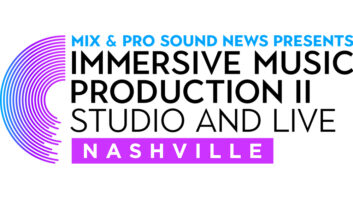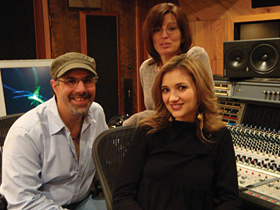
L-R: Jimmy Nichols, Tonya Ginnetti and Sarah Darling
Photo: Peter Cooper
There is Braille on the 56-channel Neve 8128, though it’s not close enough to the Flying Faders to precipitate an accident. And there’s a familiar-sounding Yamaha grand piano in the tracking room. Jimmy Nichols runs this studio now, but he still calls it “Ronnie’s Place” after its former owner, blind country superstar Ronnie Milsap.
“Ronnie told me that piano came on a ship from Japan,” Nichols said, pointing to the Yamaha C9. “He said the ship docked in L.A., and that it went by truck to the studio. He said they set it up and didn’t even have to tune it.”
When Ronnie’s Place was actually Ronnie’s place, it was called Groundstar. There, Milsap recorded hits including “Smoky Mountain Rain,” “Stranger in My House” and “Lost in the Fifties Tonight.” Opened for business in 1963, the studio has also been home to recordings by Johnny Cash, Ricky Skaggs, Merle Haggard and numerous others. Roy Orbison bought the building in 1972, and held onto it until Milsap purchased it in 1978.
But historical value doesn’t guarantee viability in the modern studio world, as Nichols is well aware. Today, Ronnie’s Place is the centerpiece of the Black River Music Group, which seeks to use the studio as a place to generate recordings that are marketed through the digital marketplace and through terrestrial radio.
The first Black River album released was Jeff Bates’ self-titled effort, and the group is now preparing Sarah Darling’s debut album. Darling is the group’s flagship artist, and the setup for her album involves Internet vignette videos and radio promotion. Nichols expects the roll-out to be cutting edge, yet the album has some decidedly old-school elements.
“We didn’t do any tuning on Sarah’s record, and we didn’t insist on filling up every empty space with fiddles and guitars,” says Nichols, who played keyboards, sang harmony vocals and produced the album with engineering help from house engineer Ben Warner. “One radio guy said, ‘Where are all the fills?’ Maybe if you have a singer that’s interesting enough and makes you hang on every word, that’s enough. Everything about this production is about Sarah’s voice, not about fitting her into a mold.”
To capture that voice, Nichols used Korby Kat System microphones made in Nashville at Korby Audio Technologies and situated within the Blackbird recording complex. Most of the time, reverb came from two EMT plate reverbs that are housed in a closet above the main recording floor and next to a balcony conceived for string sections and other kinds of ensemble recording.
“There’s nothing like those EMTs,” Nichols says. “They’re special, but not obvious, and they’re never intruding. We have so many toys and plug-ins, but I use these 90 percent of the time.”
The album was recorded through the Neve into Pro Tools HD3. For mixing, Kevin Beamish used Apogee converters and mixed on Logic. Darling was less interested in the details of the thing than in the feeling of working in a place where some of her heroes recorded.
“This place has a vibe about it,” she says. “It’s got a presence. You can tell there’s a history, and I found that I’m very creative when I’m in here. There’s a magic to it.”
“People panic about the state of the industry, but I don’t think rooms like this will ever go away,” Nichols says. “Sure, you can mix at home, in the box. But to track in a room like this, with the ambiance and the grand piano and the plate reverbs is something completely different. That doesn’t mean you can get greedy. We’re booking right now at about 85 percent of the time, but that doesn’t mean we can say, ‘We’re running a successful A room, so let’s build a B and C.’ It’s about being small and being smart and knowing what your assets are.”
Outside of the Black River Music Group, recent Ronnie’s Place projects have included sessions from John Oates and Shelly Fair-child. In addition to Pro Tools, the studio boasts two Studer analog tape recorders, and the keyboard arsenal also features a Wurlitzer and a Rhodes that Milsap used on hit sessions. The far-field monitors are TADs that were time-aligned by Milsap’s right-hand engineering man, Ben Harris.
Nichols is married to Black River VP/director of artist relations Tonya Ginnetti, and the family feel at Ronnie’s Place is accentuated by frequent visits from Nichols’ mentor, producer David Malloy. With Malloy, Nichols worked on projects from Reba McEntire, Mindy McCready and numerous others.
“We were working with Reba when David took me aside, and said, ‘Jimmy, you’ve got to decide,’” Nichols remembers. “He said, ‘At some point, you’re going to have to make a choice. You can’t do everything. You’ll have to be an engineer or a songwriter or a piano player or a vocalist. You can’t do it all.’ That is the only thing in my 14 years of working with David that he’s been wrong about. He’s been right about so much else, though. And he’s been a model for drawing from experience but staying current. Now, I’m loving that I can have a historic room like this and still stay progressive.”
Send Nashville news to
skylinemix@live.com.
